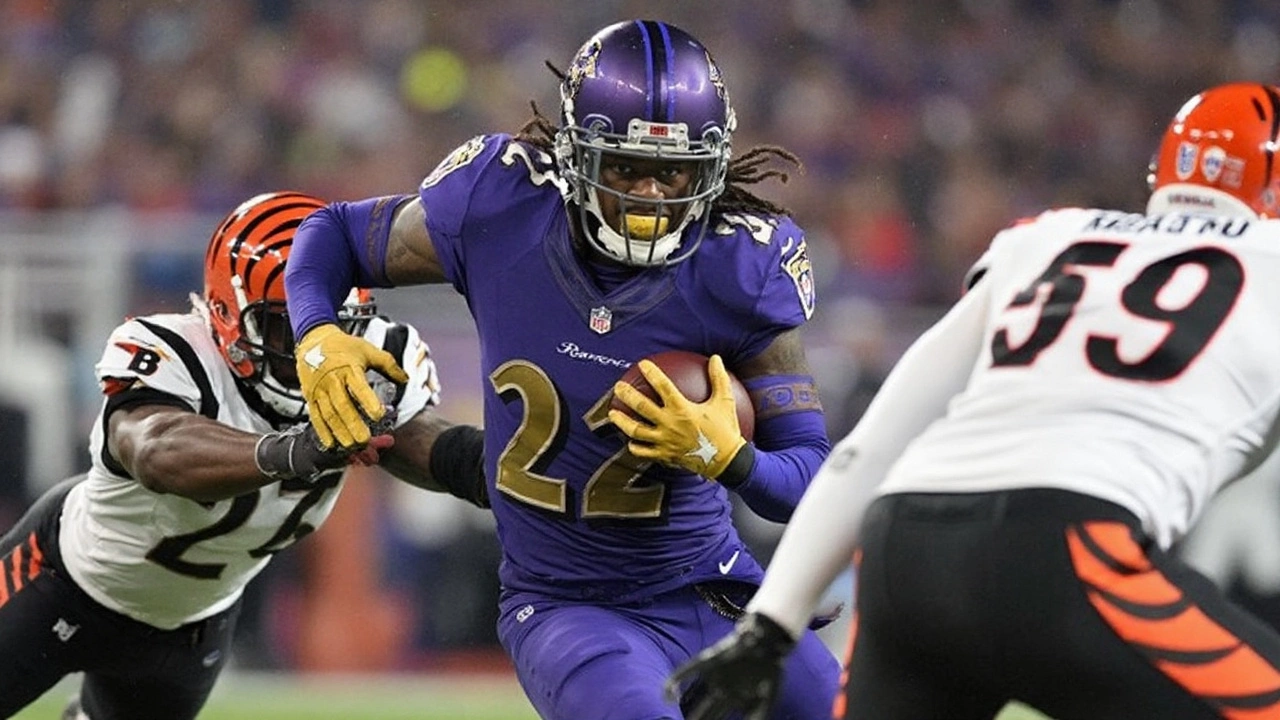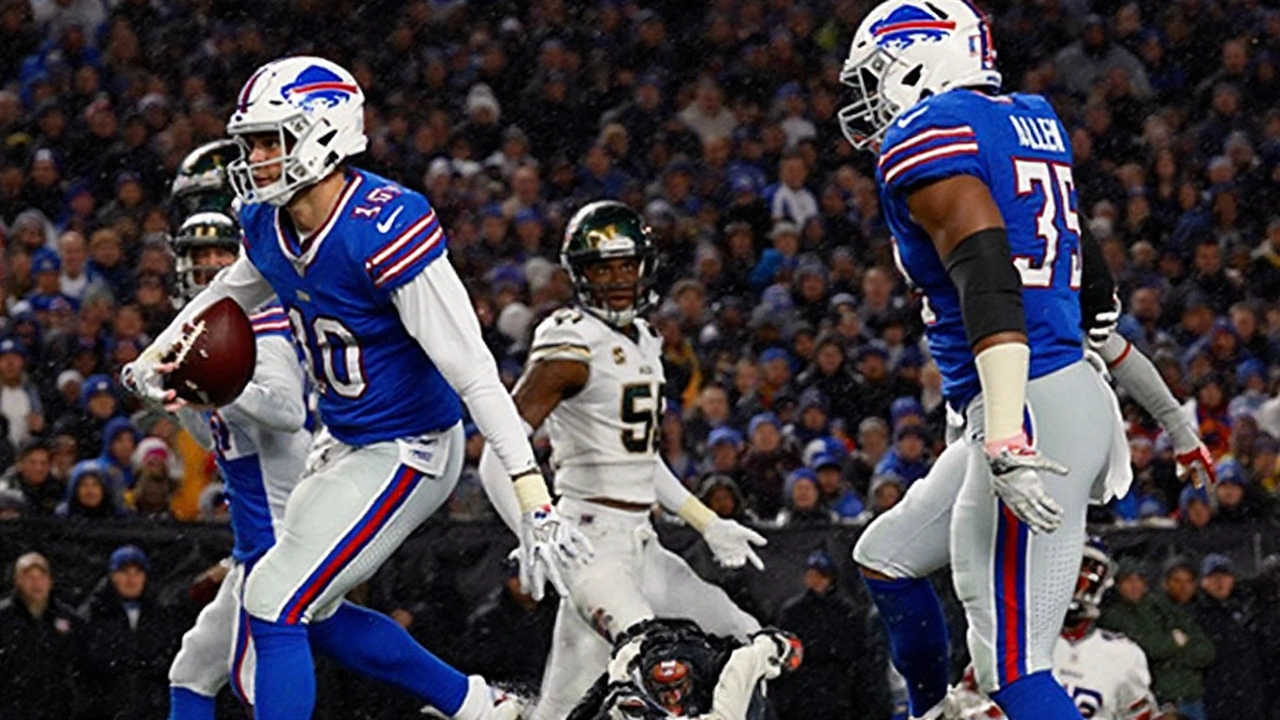Ravens vs Bills Anytime Touchdown Props: Derrick Henry headlines SNF odds and value picks
 Sep, 8 2025
Sep, 8 2025
Touchdowns expected in a high-total SNF opener
Two MVP quarterbacks under the lights, a total set in the 50s, and a market loaded with anytime touchdown props—the Ravens-Bills opener has the makings of a scoring showcase. Books are pricing multiple Baltimore and Buffalo skill players at playable numbers, and the menu ranges from short favorites to juicy long shots if you’re chasing a bigger payout.
If you’re new to this market, “anytime touchdown” means a player scores a rushing or receiving TD at any point in the game (overtime counts). Passing touchdowns do not qualify for the quarterback who throws them; only the receiver or rusher gets credit.
Context matters here. Baltimore leaned on its ground game in scoring territory last season, and the arrival of Derrick Henry gives the Ravens a true hammer at the goal line. Buffalo, meanwhile, continues to feature Josh Allen as a primary red-zone runner, mixing QB power, draws, and sneaks. Those tendencies set the stage for several clear targets—and a few worthwhile swings.

Odds and angles: favorites, values, and live long shots
Derrick Henry (-160)
Oddsmakers have Henry as the most likely scorer on the board. A -160 price implies around a 61.5% chance he finds the end zone (160 / [160 + 100]). Baltimore imported Henry to finish drives, and his role inside the 10 should be heavy. Yes, Lamar Jackson remains a threat to keep on the edge, but Henry’s short-yardage profile is why the number is this short. If the Ravens reach the red zone a handful of times—as the total suggests—they’re going to let Henry slam away behind a physical front.
Mark Andrews (+135 to +175)
Andrews’ band of prices across books tells you to shop around. The range implies a 42.6% to 36.4% chance of a TD. The résumé is there: in 2024 he caught 55 of 69 targets, delivered a career-best 68.1% receiving success rate, and scored a career-high 11 touchdowns, including one in each of his final six games. He remains Jackson’s most reliable red-zone target, especially on seams, crossers, and back-shoulder throws against zone. Much has been said about his late drop in a prior Buffalo playoff loss, but the body of work points to consistent usage when the field shrinks.
Josh Allen (+100)
Even money reflects a straight 50% implied chance, and it fits how Buffalo uses its quarterback near the goal line. Allen punched in 12 rushing touchdowns last season on 102 carries for 531 yards and scored twice on the ground the last time these teams met in the postseason. With the Bills winning 22 of their last 25 home games across three seasons, the environment favors Allen’s high-leverage role on keepers and sneaks.
Here’s a quick snapshot of those short prices and what they mean in probability terms:
- Derrick Henry -160: ~61.5% implied
- Mark Andrews +135 to +175: ~42.6% to ~36.4% implied
- Josh Allen +100: 50.0% implied
Rashod Bateman (+250)
Bateman is the most interesting mid-range option. He broke out with nine touchdowns in 2024, five in the red zone, and led Baltimore with five receiving TDs against zone coverage. That last part matters: Buffalo played zone at a top-eight rate last season while landing bottom-10 in passing yards and receiving touchdowns allowed. Bateman’s knack for settling into voids and creating after the catch makes him a clean fit if the Bills stay in those shells. At +250, you’re looking at roughly a 28.6% chance he scores, and the game script supports spikes in WR efficiency if the Bills sell out to contain Henry and Andrews inside.
Tai Johnson (+750)
This is your long shot with a plausible path. Johnson scored four touchdowns in 2024 and appeared to climb the depth chart late, logging snap counts close to James Cook. He also led all running backs in downfield targets, turning that aggressiveness into three receiving touchdowns. If Baltimore jumps ahead and Buffalo needs to throw more, Johnson’s vertical routes and screen work keep him live. The +750 price implies about an 11.8% chance—low, but not outlandish given his usage profile in catch-up scenarios.
Keon Coleman (+185)
Rookie receivers can be volatile, but Coleman’s red-zone traits are obvious. His size and contested-catch ability give Allen a high-point outlet on fades and slants, especially if the Ravens lean into pressure and leave corners on islands in the low red zone. At +185, the implied probability sits near 35.1%, a fair number for a player likely to see scripted looks inside the 20 as Buffalo tests new weapons.
How the pieces fit together
Baltimore’s identity is built on efficiency and leverage. Inside the five, Henry should see the first crack. On obvious passing downs or when Jackson extends plays, Andrews remains the first read, with Bateman the zone-beater who can win early in routes. If the Bills tilt safeties and squeeze seams to bracket Andrews, the backside one-on-one opens for Bateman, especially on glance routes and digs.
Buffalo’s plan often starts with Allen’s legs. Short yardage? Expect sneak variations behind motion and misdirection. In the high red zone, Allen can stress edges with rollouts and RPO looks that isolate a defender. That’s where Coleman’s frame can matter on crossers and posts, while Johnson’s wheel routes and delayed releases punish linebackers who overcommit to Allen.
Game-flow notes that affect TD chances
- Ravens lead early: Increased Henry volume and more layered play-action near the goal line, boosting Andrews’ and Bateman’s chances.
- Bills lead early: More designed Allen runs in short yardage and expanded passing usage for Johnson and Coleman in the middle of the field.
- Tight, back-and-forth: Higher total plays and more red-zone trips for both sides, keeping favorites and mid-range options in play throughout the fourth quarter.
Parlay math and correlation
Single-player odds roll up nicely in parlays, but your combined probability drops fast. A Bateman + Johnson ticket pays 28-to-1 at DraftKings, a big number but a reminder that multiple touchdowns require multiple trips and the right sequencing. Correlation can be a double-edged sword: if Baltimore scores through Henry and Andrews early, the script might force Buffalo to the air, which helps Johnson and Coleman. But if long drives end in field goals or defensive stands, your multi-leg bet can sink despite good volume.
Why Henry and Andrews can both get there
There’s room for both in the same game because their touchdown paths complement each other. Henry owns the goal-line bruising work. Andrews thrives from the 8-to-20 yard range where spacing and leverage matter most. Baltimore’s heavy play-action near the stripe—especially from condensed formations—forces linebackers downhill, opening Andrews on pop passes and quick seams even when everyone expects Henry.
Allen’s short-yardage edge
Few teams are more comfortable than Buffalo with the ball on the one. The Bills have leaned into Allen’s size and power, turning sneaks and keepers into high-success plays. With new faces rotating through the receiving corps, the most stable red-zone role in Buffalo still belongs to the quarterback who can bully his way over the line when the margins are tight.
Market movement and timing
The Andrews range (+135 to +175) is your reminder to compare prices across books. Lines can tighten closer to kickoff, especially if injury reports or weather nudge offensive plans. If heavy wind shows up in Orchard Park, it typically boosts rushing equity (Henry, Allen) and lowers downfield target value; calm conditions help the mid-range receiving profiles (Bateman, Coleman).
Quick reference: implied probabilities at a glance
- Rashod Bateman +250: ~28.6%
- Tai Johnson +750: ~11.8%
- Keon Coleman +185: ~35.1%
Definitions that save confusion
- Anytime TD includes rushing and receiving touchdowns only.
- Passing TDs credit the receiver, not the quarterback who threw it.
- Overtime counts; a walk-off score still cashes.
- Non-offensive TDs (pick-sixes, kick returns) only count for the player who scores, not offensive props.
Coaching tendencies to know
Under Todd Monken, Baltimore uses formation variety to stress safeties and isolate matchups, especially near the red zone. The result: clean windows for Andrews and fewer bodies needed to clear space for Henry. With Joe Brady steering Buffalo’s offense, the Bills have leaned into concepts that keep Allen as a run-first threat inside the 10 while giving bigger-bodied targets simple leverage wins. That keeps the TD tree tight even as new receivers settle in.
The case for each angle in one line
- Derrick Henry: Designed to finish drives; the goal-line role is clear.
- Mark Andrews: Red-zone chemistry with Jackson plus sustained late-season scoring.
- Josh Allen: The most reliable short-yardage runner on the field.
- Rashod Bateman: Zone-beating profile lines up with how Buffalo defends.
- Tai Johnson: Passing-down and downfield usage pops if the Bills chase.
- Keon Coleman: Rookie size and contested-catch skill translate near the stripe.
With a high total, two aggressive offenses, and defined red-zone roles on both sidelines, the board offers something for every risk appetite—from short chalk on Henry to long-shot sprinkles on Johnson. Monitor prices, watch the injury and weather updates, and line up the player paths with the likely game flow before kickoff on Sunday night.